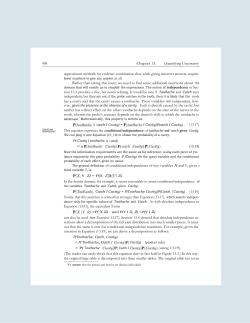
Cryogenics and Superconductivity Introduction Why superconducting Linac? Challenges of Cryogenics for Linac
Cryogenics and Superconductivity at IUAC Amit Roy Inter-University Accelerator Centre Introduction Why superconducting Linac? Challenges of Cryogenics for Linac The IUAC facility INTRODUCTION Interaction of Cryogenics & Nuclear Science have produced many spectacular breakthroughs. Some of these are: Extreme low temperatures through nuclear adiabatic demagnetisation. Polarised targets for nuclear experiments. High field magnets for particle accelerators. Cryogenic detectors for high precision spectroscopy. Superconducting Cavities for Particle Accelerators. Why Superconducting Linac? Large Accelerating Fields required. Electric fields generated in Resonant cavities. Resonant cavities have Quality factors, Q, whose value depend on resisitive losses. Skin Depth ~ few µm f > 100 MHz. Surface Resistance is all important. For Cu at 300 K, RS = 7.8 [f(GHz)]1/2 mΩ For Nb at 4.2 K, RS = 105 [f(GHz)]2 exp[-18/T(K)] / T(K) nΩ RS Cu (300K) Nb (4.2K) at 100 MHz 0.078 mΩ 3.28 nΩ 300 MHz 0.96 mΩ 40 nΩ 1GHz 7.8 mΩ 328 nΩ For Superconducting surfaces, additional contribution from residual resistance, Rres BCS surface resistance of Nb vs frequency at 4.2 K (extrapolated to 1.8 K). Frequency dependence of the surface resistance at 77 K for polycrystalline (full marks) and single crystalline (open marks) YBa2Cu3O7-δ samples. Solid line -Cu @77 K Dashed line-Nb@7.7 K Comparison of surface resistance of Nb with A15 material Nb3Sn Power dissipated in a cavity, P = 2.π.f.U/Q For Room temperature Cu Cavity, Q (max) = 10,000 Assume, U= 1 Joule, 1 MV/m E field@ 100 MHz , P = 6.3 kW For Superconducting Nb Cavity At 4.2K, Q = 109 1 MV/m E field@ 100 MHz , P = 0.063 W However, some power is required to provide liq He. Add static heat load ~ 2W and with cryogenic efficiency (hcr ~ 3. 10-3) factored in, P = 2.1/hcr = 700 W For achieving 4.2 K, require LHe, LN2 . W Dynamic Heat Load W Static Heat Load W Load of the Distribution system Production of Cryogen. W Liquid helium refrigerator W Liquid Nitrogen supply for shields & precooling Distribution of Cryogen. W Transfer Lines W Valve Boxes W Measurement of temperature, cryogen levels Requirement of Cryogen for NSC Linac Estimated Load@ 4.5 K Static Load Dynamic Load 3 Linac Cryostats 60 W 180 W Superbuncher Cryostat 5 W 5W Rebuncher Cryostat 5W 10 W Distribution 60 W ____________________________________________________ Total 130 W 195 W Total Load @4.5 K = 325 W (Eqv ~ 455 l/hr) Estimated Load@ 80 K Static Load Dynamic Load 3 Linac Cryostats 1215 W 600 W Superbuncher Cryostat 90 W 50 W Rebuncher Cryostat 90 W 100 W Distribution 600 W Precooling of He 2025 W ____________________________________________________ Total 4020 W 750 W Total Load @4.5 K = 4770 W(Eqv ~110 l/hr) Challenges of Cryogenics Maintain cavity surface below Tc of Nb, 9.2 K Feed RF power into the cavity from room temperature to LHe temperature. Large variable dynamic load. Maintain alignment of the cavities to the beam axis. Minimise the coupling of mechanical noise from outside to cavities. Minimise pressure fluctuations in the Helium system. Large number of penetrations from outside to LHe temperature. Quick cool-down and warm-up of large mass. Recovery & Purification of He gas. Precautions for Power failures ( Important in India) Gaseous He Impure He Purifier Rebuncher Storage Tanks Dewar Linac Modules He Compressors Superbuncher Gas Bag Recovery Compressors He Cylinders Comparison of microphonics for a Nb superconducting resonator Witho ut any SS-b alls With 8 0 SS-b alls No. of occurrence 10 0 0 0 0 10 0 0 0 10 0 0 10 0 10 1 -6 0 -4 0 -2 0 0 20 40 Delta f (frequency variations) in Hz 60 First indigenous cavity, electron beam welded at NSC Cavity Resonator being mounted in the test cryostat. TOP HAT SLOW TUNER NEW RF DRIVE Valve Box assembly Triple Jacketed He transfer line Insert Type Superconducting Solenoid 7.1 T @ 215 A Inner Bore: 46 mm Outer Diameter: 83 mm Length: 150 mm The Axial Field Profile of the Magnet at ~ 5Tesla Magnetic Field [Tesla] 5 4 3 2 1 Field Homogeneity ~ 0.072% over 20 SDV 0 -14 -12 -10 -8 -6 -4 -2 0 2 4 6 8 Axial Distance From Mid Point [cm] 10 12 14 C vs LN2 level of Indigenous sensor LN2 sensor 4E-10 sensitivity = 3.7pf/ cm 3.5E-10 3E-10 2.5E-10 liquid level (cm ) -> 37 33 29 25 21 17 13 9 5 2E-10 1 capcitance in pf -> 4.5E-10 He Impurity Monitor Superconducting Quadrupole Magnet for HYRA World's First High Temperature Superconductor based ECR source. Thank You
© Copyright 2025





















